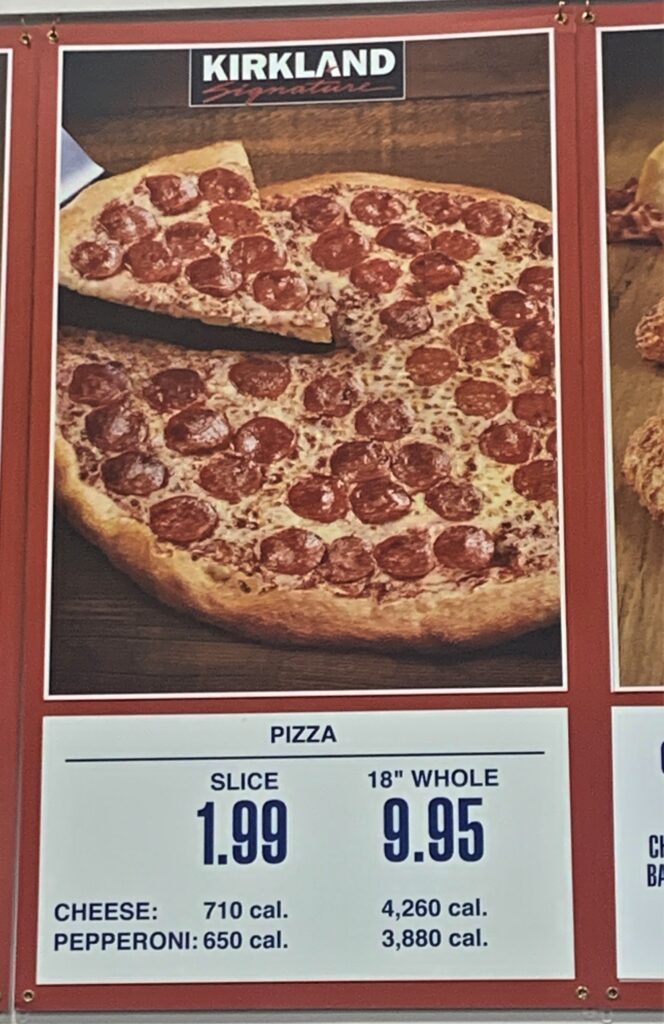What’s wrong with this sign?
There are two mysteries about the numbers on this sign. It’s very odd that the cheese pizza has more calories than the pepperoni. Do pepperoni slices have negative calories? Could those numbers reflect reality? Well, yes, they could. The pepperoni pizza could have less cheese in it. It’s not a topping on a cheese pizza, it’s a replacement for cheese in the cheese pizza. (Darn it, I’m not the first to notice this! Reddit was all over it.)
The bigger mystery is the ratios. The calories in a cheese pizza are are exactly six time the calories in a cheese slice. Presumably the pizza is cut into sixths to make individual slices. That matches common sense, so far so good. But the calories for pepperoni pizza are not in that ratio, the pizza is only 5.969 as caloric as an individual slice. The pizza is being cut into 5.969 slices? That doesn’t make sense, the ratio should be a nice whole number (and divisible by two). And the ratio should be the same for both options, they wouldn’t cut cheese pizzas differently than pepperoni.
Could this be a rounding error? 650 calories for one slice times six slices would equal 3,900 calories for the whole pizza. That would be an even easier number to display and understand. But if you go the other way, the likely story reveals itself. 3,880 calories (as displayed) divided by six slices is 646.66 calories. If you round that the nearest ten-calories, you get the 650 that is displayed on the sign.
It still doesn’t seem correct though. Under the rounding hypothesis, they measured the entire pie, wrote that down, and the divided it by six to get the individual slice number. If this is true though, then we need to accept that the cheese pizza just happened to be a perfect multiple of six, while also being a nice round number. That is possible, but. We conclude it is unlikely that the same calculation method was done for both the cheese and pepperoni. The numbers reveal a likely inconsistency in methodology.
You may be wondering how precise these numbers need to be? (You are more likely wondering what the hell is wrong with my brain that I’ve spent this much effort noticing and thinking through the inconsistencies. I can’t help it. Yes, I noticed the math discrepancies while waiting in line. Just wired that way.) It turns out the FDA accepts a 20% margin of error in calorie counting. Twenty percent! That’s a lot! It’s probably safe to say that almost every displayed calorie count you have ever seen has been understated by close to 20%, as close as the manufacturer can make it. That margin of error seems crazy high to me, particularly for mass produced foods that are made and packaged through a consistent manufacturing process.
As applied here, twenty percent means that Costco could have very easily kept all these ratios consistent. The simplest approach would have been to display the pepperoni pizza at 3,900 calories and each slice at 650. The numbers are nice and round and the ratios stay consistent. They did not. Why not? Because someone over there doesn’t understand math and how to use numbers to convey information.

Well how about that. Thank you Mike. I mean, no thanks for destroying my blog post, but thanks for bringing the knowledge!
And yes Brian, the 20% is probably the more interesting part of this!
The math is confusing me(my brain hurts trying to understand Costco’s logic with that display), but what really got my attention is this 20% range for calories displayed(?!). This is actually the first time I’ve heard about it and it’s quite surprising.
Copied from https://labelcalc.com/a-guide-to-using-fda-rounding-rules-for-your-food-label/ , which is a plain English summary of https://www.fda.gov/regulatory-information/search-fda-guidance-documents/guidance-industry-guide-developing-and-using-data-bases-nutrition-labeling
If your product has:
• Fewer than 5 calories per serving, round down to zero.
• 50 or fewer calories per serving, round to the nearest 5 increment (i.e. 42 rounds to 40).
• More than 50 calories per serving, round to the nearest 10 increment (i.e. 106 becomes 110).